Influence of Pore Size and Fatigue Loading on NaCl Transport Properties in C-S-H Nanopores: A Molecular Dynamics Simulation
Abstract
1. Introduction
2. Molecular Dynamics Simulation Theory
- (1)
- Establish the micro-structural system needed for a specific project.
- (2)
- Given the initial position and velocity of each atom in the micro-structural system, the appropriate potential function is adopted to calculate the load on each atom. The following two formulas are the speed and position of atom i at time t, which are the core of the numerical solution equation of molecular dynamics simulation. The correctness of the atom’s numerical solution depends on U (potential function).
- (3)
- Based on the obtained position, velocity, and load of the atom at each time, the atom at the upper position is pushed to a lower energy state in a small-time interval, thus generating a new position and velocity.
- (4)
- The positions and velocities of the atoms are updated in the established micro-structural system. The simulation steps mentioned above are repeated until the properties of the system do not change with time, and the structure of the system reaches a stable state. The trajectories of all atoms in the micro-structural system can be obtained.
3. Molecular Dynamics Simulation Details
3.1. Molecular Modeling of NaCl Transportation in C-S-H
3.1.1. Molecular Modeling of C-S-H
3.1.2. Molecular Modeling of NaCl Solution
3.1.3. Molecular Modeling of NaCl in the C-S-H Pore Structure
3.2. Fatigue Loading Application
3.3. Mean Square Displacement (MSD)
4. Results and Discussion
4.1. Influence of Pore Size on NaCl Transport Properties in C-S-H Nanopores
4.2. Influence of Fatigue Loading on NaCl Transport Properties in C-S-H Nanopores
4.3. Discussion
5. Conclusions
- (1)
- Ca2+ and Na+ in the pore wall of C-S-H nanopores can adsorb chloride ions, attracting chloride ions to move towards the pore wall. The attraction effect varies with the pore diameter of C-S-H nanopores. The larger the pore diameter is, the weaker the attractive interaction of the pore walls to chloride ions. The C-S-H pore wall had a strong adsorption effect for cations. The amount of Cl− adsorbed in the solution increases with the increase of the amount of Na+ adsorbed on the pore wall, in which case, chloride ions will be adsorbed to the surface of the pore wall of C-S-H nanopores. In addition, some Cl− will be adsorbed by free Ca2+ in the pore wall of C-S-H nanopores and move to the interior of the C-S-H pore structure.
- (2)
- The C-S-H pore structure is continuously deformed by extrusion under fatigue loading, which leads to the expansion of pore size, thus increasing the chloride diffusion rate. At the same time, more chloride ions will penetrate the concrete cover and diffuse to the surface of reinforcement, which leads to a great increase in the corrosion probability of reinforcement and a decrease in the durability of reinforced concrete structure.
- (3)
- The diffusion coefficient of water molecules in C-S-H nanopores with a pore size of 3 nm obtained from the MD simulation is 1.794 × 10−9 m2/s, which is slightly lower than that obtained from the experiment. This is attributed to the diffusion coefficient of the particles obtained by the experiment being the result of the particles being transported in a large number of pores with different pore sizes.
- (4)
- In this paper, only the transmission process of chloride ions in a single nanopore is considered. The concrete composites contain variety of pore structures with different size. A molecular model with different pore sizes and structures should be established, which can further improve the accuracy of numerical simulation.
Author Contributions
Funding
Acknowledgments
Conflicts of Interest
References
- Shi, X.M.; Xie, N.; Fortune, K.; Gong, J. Durability of steel reinforced concrete in chloride environments: An overview. Constr. Build. Mater. 2012, 30, 125–138. [Google Scholar] [CrossRef]
- Jiang, W.Q.; Shen, X.H.; Xia, J.; Mao, L.X.; Yang, J.; Liu, Q.F. A numerical study on chloride diffusion in freeze-thaw affected concrete. Constr. Build. Mater. 2018, 179, 553–565. [Google Scholar] [CrossRef]
- Lehner, P.; Konecny, P.; Ponikiewski, T. Experimental and Numerical Evaluation of SCC Concrete Durability Related to Ingress of Chlorides. In Proceedings of the International Conference of Numerical Analysis and Applied Mathematics (ICNAAM), Thessaloniki, Greece, 25–30 September 2017. [Google Scholar]
- Yu, Z.; Chen, Y.; Liu, P.; Wang, W. Accelerated simulation of chloride ingress into concrete under drying-wetting alternation condition chloride environment. Constr. Build. Mater. 2015, 93, 205–213. [Google Scholar] [CrossRef]
- Jee, A.A.; Pradhan, B. Study on development of empirical relationships between durability parameters of concrete made with different types of binder and exposed to chloride environment. Constr. Build. Mater. 2019, 212, 799–817. [Google Scholar] [CrossRef]
- Nemecek, J.; Kruis, J.; Koudelka, T.; Krejci, T. Simulation of chloride migration in reinforced concrete. Appl. Math. Comput. 2018, 319, 575–585. [Google Scholar] [CrossRef]
- Tu, X.; Li, Z.; Chen, A.; Pan, Z. A multiscale numerical simulation approach for chloride diffusion and rebar corrosion with compensation model. Comput. Concr. 2018, 21, 471–484. [Google Scholar] [CrossRef]
- Carsana, M.; Gastaldi, M.; Lollini, F.; Redaelli, E. Durability-Related Properties of Concrete Made with Chloride-Contaminated Materials. Adv. Civ. Eng. Mater. 2019, 8, 110–127. [Google Scholar] [CrossRef]
- Zhang, P.; Wittmann, F.H.; Vogel, M.; Mueller, H.S.; Zhao, T. Influence of freeze-thaw cycles on capillary absorption and chloride penetration into concrete. Cem. Concr. Res. 2017, 100, 60–67. [Google Scholar] [CrossRef]
- Xu, Y. The Corrosion Characteristics and Tensile Behavior of Reinforcement under Coupled Carbonation and Static Loading. Materials 2015, 8, 8561–8577. [Google Scholar] [CrossRef] [PubMed]
- Li, H.; Li, B.; Jin, R.; Li, S.; Yu, J.-L. Effects of sustained loading and corrosion on the performance of reinforced concrete beams. Constr. Build. Mater. 2018, 169, 179–187. [Google Scholar] [CrossRef]
- Shen, J.; Gao, X.; Li, B.; Du, K.; Jin, R.; Chen, W.; Xu, Y. Damage Evolution of RC Beams Under Simultaneous Reinforcement Corrosion and Sustained Load. Materials 2019, 12, 627. [Google Scholar] [CrossRef] [PubMed]
- Yang, Y.; Wang, M. Pore-scale modeling of chloride ion diffusion in cement microstructures. Cem. Concr. Compos. 2018, 85, 92–104. [Google Scholar] [CrossRef]
- Basheer, L.; Kropp, J.; Cleland, D.J. Assessment of the durability of concrete from its permeation properties: a review. Constr. Build. Mater. 2001, 15, 93–103. [Google Scholar] [CrossRef]
- Zhou, W.; Duan, L.; Tang, S.W.; Chen, E.; Hanif, A. Modeling the evolved microstructure of cement pastes governed by diffusion through barrier shells of C-S-H. J. Mater. Sci. 2019, 54, 4680–4700. [Google Scholar] [CrossRef]
- Wu, K.; Long, J.F.; Xu, L.L.; De Schutter, G. A study on the chloride diffusion behavior of blended cement concrete in relation to aggregate and ITZ. Constr. Build. Mater. 2019, 223, 1063–1073. [Google Scholar] [CrossRef]
- Zhou, H.; Zhou, X.Z.; Zhang, J.; Zheng, J.J. Effective Medium Method for Chloride Diffusion Coefficient of Mature Fly Ash Cement Paste. Materials 2019, 12, 11. [Google Scholar] [CrossRef]
- Akkermans, R.L.; Spenley, N.A.; Robertson, S.H. Monte Carlo methods in Materials Studio. Mol. Simul. 2013, 39, 1153–1164. [Google Scholar] [CrossRef]
- Materials Studio, version 6; Biovia: San Diego, CA, USA, 2012.
- Al Hasan, N.H.J. Prediction of mechanical properties of EPON 862 (DGEBF) cross-linked with curing agent (TETA) and SiO2 nanoparticle based on materials studio. In Proceedings of the 1st International Conference on Materials Engineering and Science (IConMEAS), Istanbul, Turkey, 8–9 August 2018. [Google Scholar]
- Gholizadeh, R.; Wang, Y. Molecular dynamics simulation of the aggregation phenomenon in the late stages of silica materials preparation. Chem. Eng. Sci. 2018, 184, 62–71. [Google Scholar] [CrossRef]
- Kalinichev, A.G.; Kirkpatrick, R.J. Molecular dynamics modeling of chloride binding to the surfaces of calcium hydroxide, hydrated calcium aluminate, and calcium silicate phases. Chem. Mater. 2002, 14, 3539–3549. [Google Scholar] [CrossRef]
- Kalinichev, A.G.; Wang, J.; Kirkpatrick, R.J. Molecular dynamics modeling of the structure, dynamics and energetics of mineral-water interfaces: Application to cement materials. Cem. Concr. Res. 2007, 37, 337–347. [Google Scholar] [CrossRef]
- Minet, J.; Abramson, S.; Bresson, B.; Franceschini, A.; Van Damme, H.; Lequeux, N. Organic calcium silicate hydrate hybrids: A new approach to cement based nanocomposites. J. Mater. Chem. 2006, 16, 1379–1383. [Google Scholar] [CrossRef]
- Masoero, E.; Cusatis, G.; Di Luzio, G. C-S-H gel densification: The impact of the nanoscale on self-desiccation and sorption isotherms. Cem. Concr. Res. 2018, 109, 103–119. [Google Scholar] [CrossRef]
- Xiang, L.; Peiyu, Y.; Ruhan, A. Assessment method of hydration degree of cement in complex binder based on the calcium hydroxide content. J. Chin. Ceram. Soc. 2009, 37, 1597–1601. [Google Scholar]
- Li, W.; Guo, L.; Gao, Y.; Hong, J. Molecular dynamics simulation of chloride diffusion in concrete considering constrictivity and tortuosity of nanochannels. J. Southeast Univ. Nat. Sci. Ed. 2015, 45, 109–114. [Google Scholar]
- Hou, D.; Zhang, Q.; Li, M.; Wang, P.; Wang, X. Testing ion Diffusion Coefficient under Electric Field Based on Molecular Dynamics Comprises e.g., Using Molecular Dynamics Simulation Software Materials Studio Constructing C-S-H Mode, i.e., Hydrated Model, and Maintaining Charge Balance. CN110097927-A. G16C-010/00 201971. 6 August 2019; 11. (In Chinese) [Google Scholar]
- Mao, X.; Song, X.; Lu, G.; Xu, Y.; Sun, Y.; Yu, J. Effect of additives on the morphology of calcium sulfate hemihydrate: Experimental and molecular dynamics simulation studies. Chem. Eng. J. 2015, 278, 320–327. [Google Scholar] [CrossRef]
- Obot, I.; Gasem, Z.; Umoren, S. Molecular level understanding of the mechanism of aloes leaves extract inhibition of low carbon steel corrosion: a DFT approach. Int. J. Electrochem. Sci. 2014, 9, 510–522. [Google Scholar]
- Liang, C.X.; Chai, C.C.; Fan, Q.Y.; Yang, Y.T.; Xing, M.J. Elastic and electronic properties of M585 carbon under pressure. Chin. J. Phys. 2016, 54, 398–407. [Google Scholar] [CrossRef]
- Jennings, H.M.; Thomas, J.J.; Gevrenov, J.S.; Constantinides, G.; Ulm, F.-J. A multi-technique investigation of the nanoporosity of cement paste. Cem. Concr. Res. 2007, 37, 329–336. [Google Scholar] [CrossRef]
- Braga, C.; Travis, K.P. A configurational temperature Nose-Hoover thermostat. J. Chem. Phys. 2005, 123, 15. [Google Scholar] [CrossRef]
- Du, X.; Jin, L.; Zhang, R. Chloride diffusivity in saturated cement paste subjected to external mechanical loadings. Ocean Eng. 2015, 95, 1–10. [Google Scholar] [CrossRef]
- Ye, Y.F.; Wang, S.; Fan, J.; Liu, C.T.; Yang, Y. Atomistic mechanism of elastic softening in metallic glass under cyclic loading revealed by molecular dynamics simulations. Intermetallics 2016, 68, 5–10. [Google Scholar] [CrossRef]
- Yasbolaghi, R.; Khoei, A.R. Micro-structural aspects of fatigue crack propagation in atomistic-scale via the molecular dynamics analysis. Eng. Fract. Mech. 2020, 226, 106848. [Google Scholar] [CrossRef]
- Jiang, J.; Sun, W.; Wang, J.; Wang, C. Resistance to chloride ion diffusion of structural concrete under bending fatigue load. J. Southeast Univ. Nat. Sci. Ed. 2010, 40, 362–366. [Google Scholar] [CrossRef]
- Hou, D.; Zhao, T.; Wang, P.; Li, Z.; Zhang, J. Molecular dynamics study on the mode I fracture of calcium silicate hydrate under tensile loading. Eng. Fract. Mech. 2014, 131, 557–569. [Google Scholar] [CrossRef]
- Li, D.; Zhao, W.; Hou, D.; Zhao, T. Molecular dynamics study on the chemical bound, physical adsorbed and ultra-confined water molecules in the nano-pore of calcium silicate hydrate. Constr. Build. Mater. 2017, 151, 563–574. [Google Scholar] [CrossRef]
- Savin, T.; Doyle, P.S. Static and dynamic errors in particle tracking microrheology. Biophys. J. 2005, 88, 623–638. [Google Scholar] [CrossRef] [PubMed]
- Montiel, D.; Cang, H.; Yang, H. Quantitative characterization of changes in dynamical behavior for single-particle tracking studies. J. Phys. Chem. B 2006, 110, 19763–19770. [Google Scholar] [CrossRef]
- Chitra, R.; Yashonath, S. Estimation of error in the diffusion coefficient from molecular dynamics simulations. J. Phys. Chem. B 1997, 101, 5437–5445. [Google Scholar] [CrossRef]
- Takahara, S.; Sumiyama, N.; Kittaka, S.; Yamaguchi, T.; Bellissent-Funel, M.C. Neutron scattering study on dynamics of water molecules in MCM-41. 2. Determination of translational diffusion coefficient. J. Phys. Chem. B 2005, 109, 11231–11239. [Google Scholar] [CrossRef]
- Majolino, D.; Corsaro, C.; Crupi, V.; Venuti, V.; Wanderlingh, U. Water diffusion in nanoporous glass: An NMR study at different hydration levels. J. Phys. Chem. B 2008, 112, 3927–3930. [Google Scholar] [CrossRef]

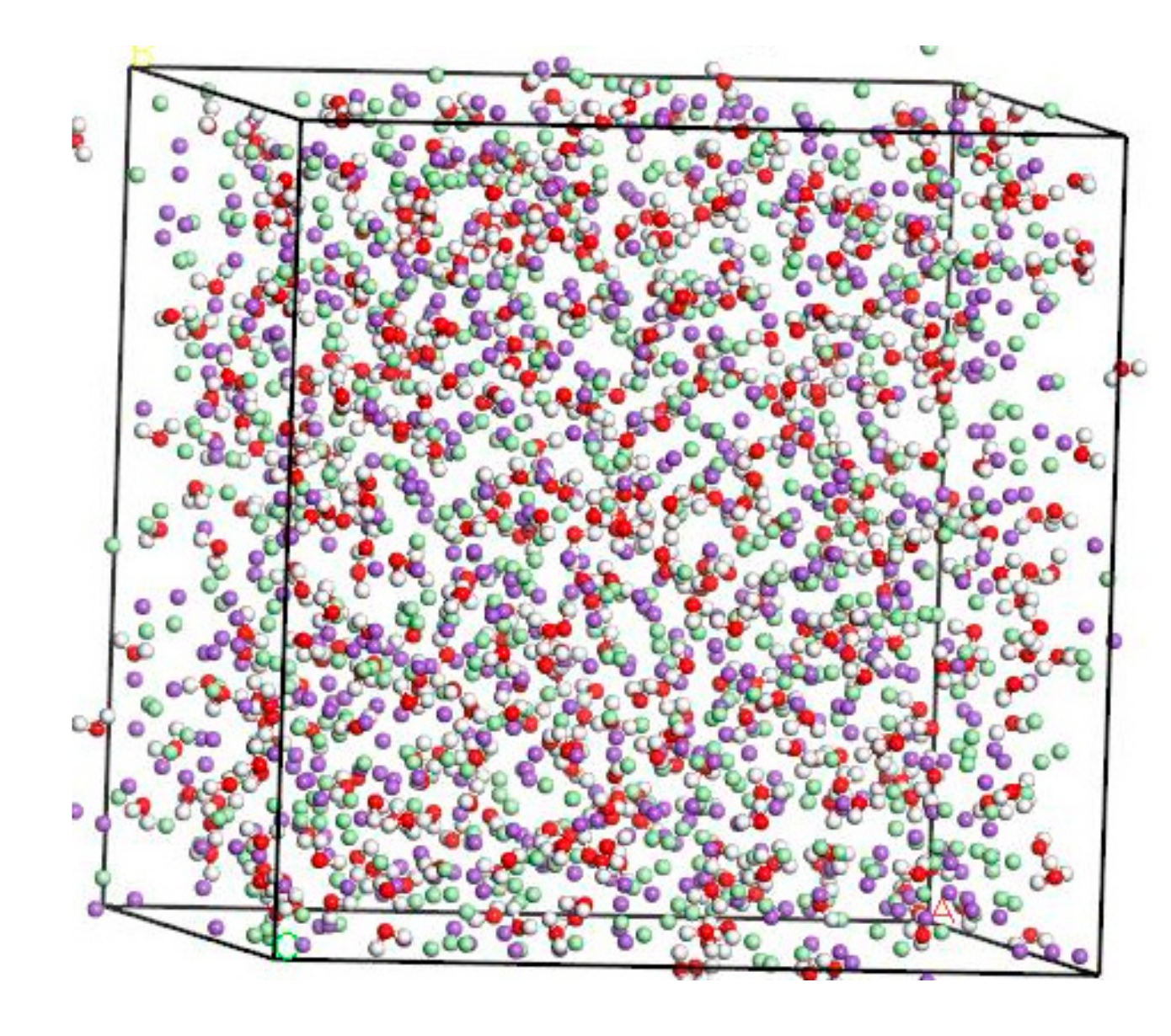
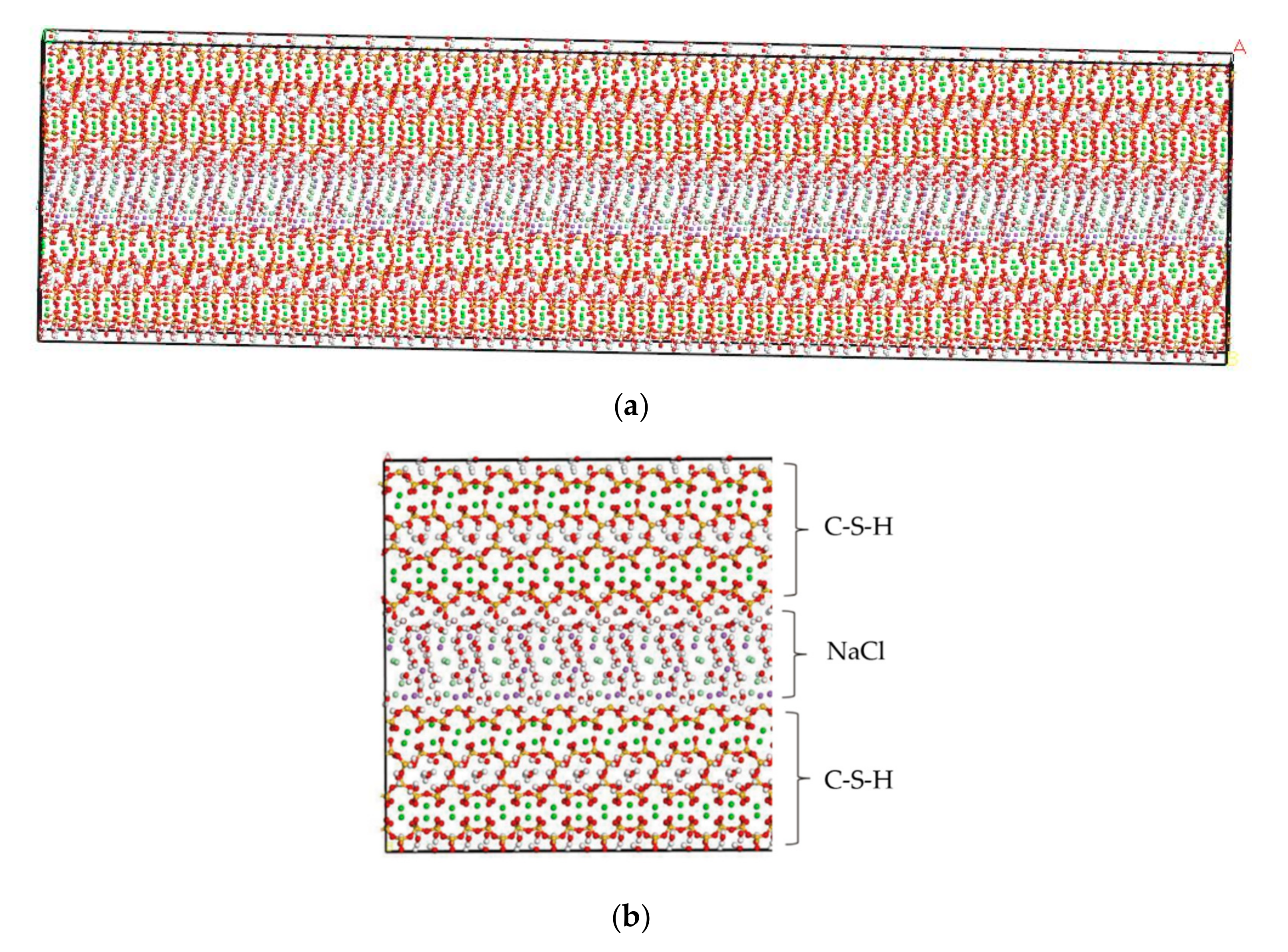
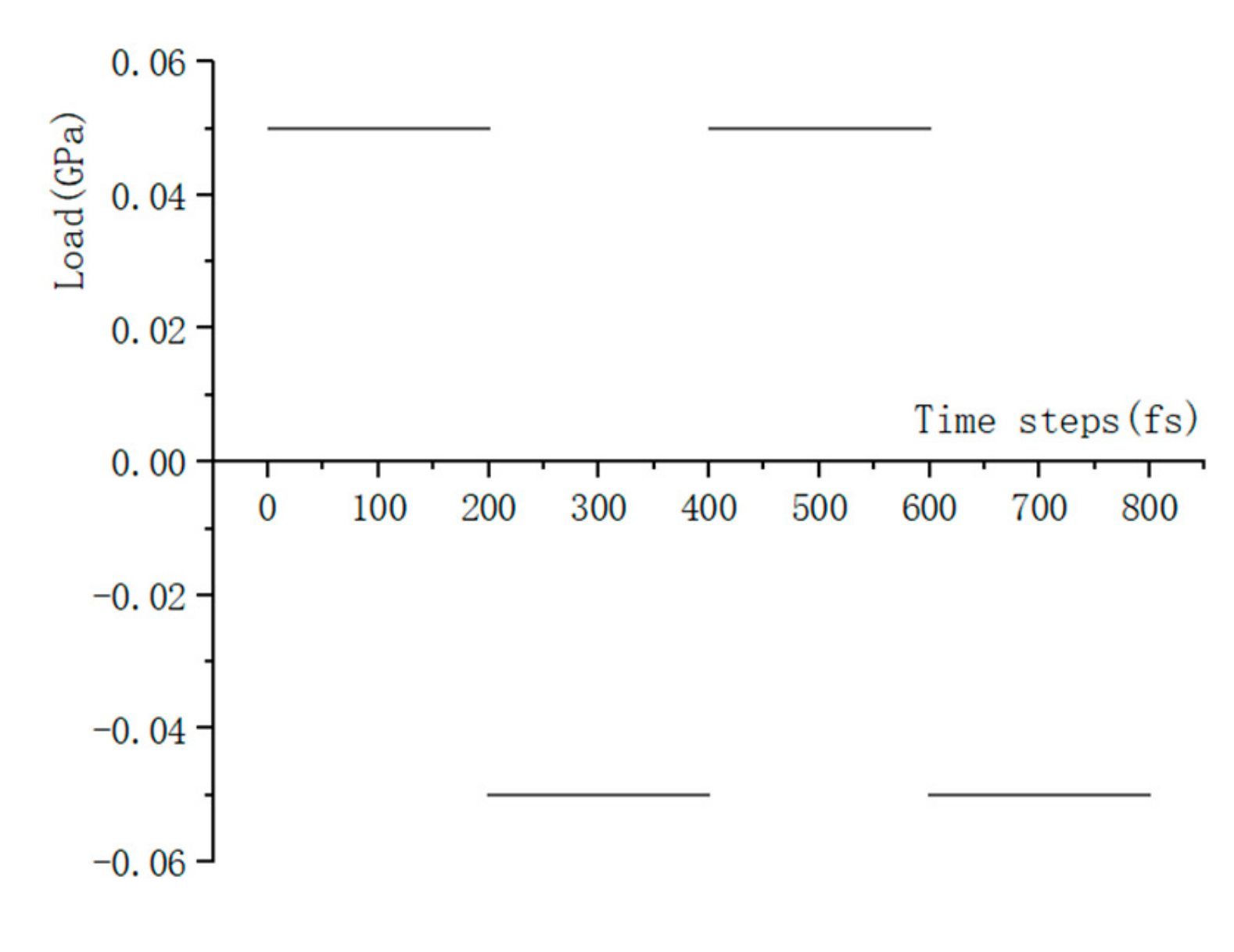
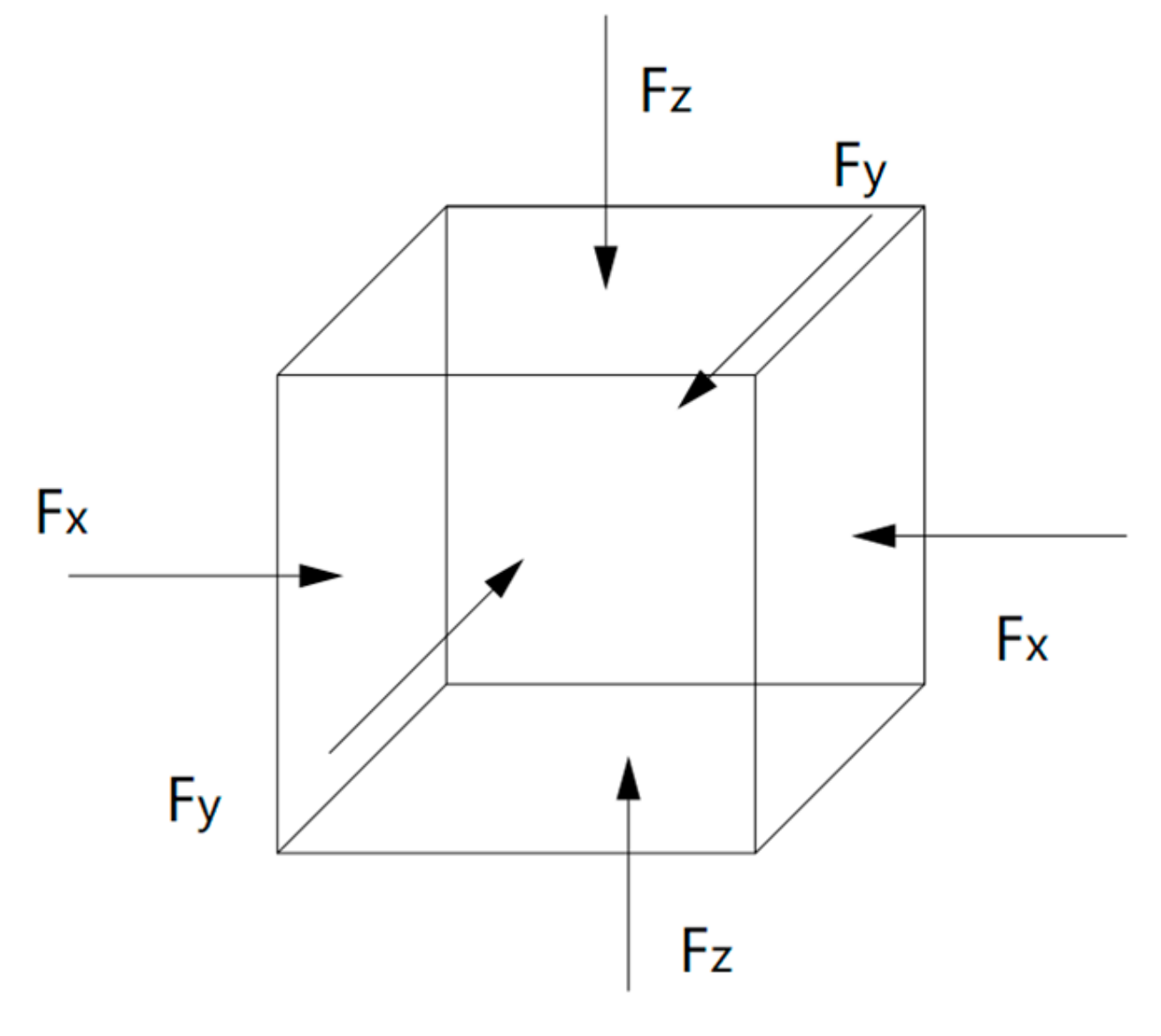
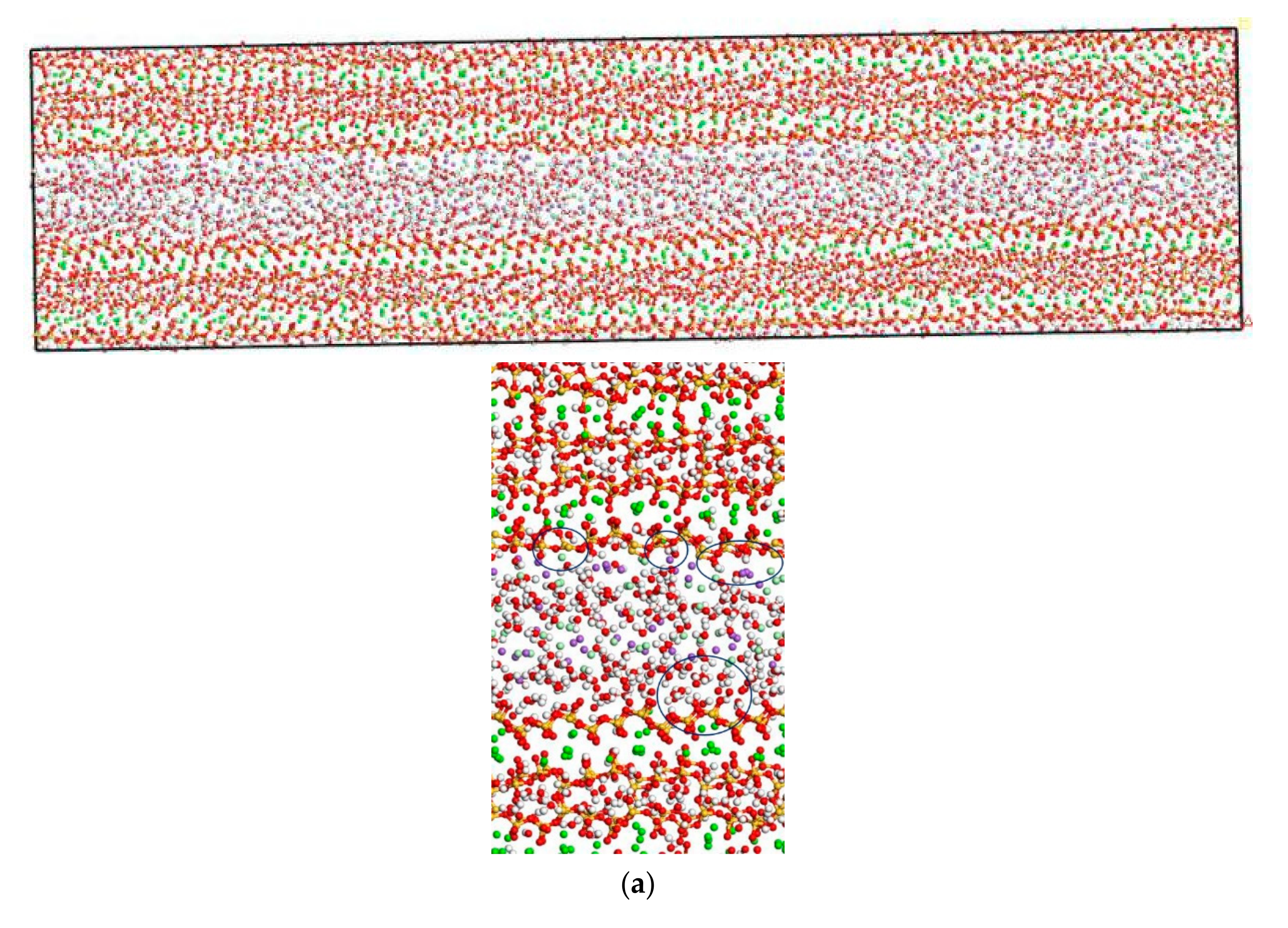
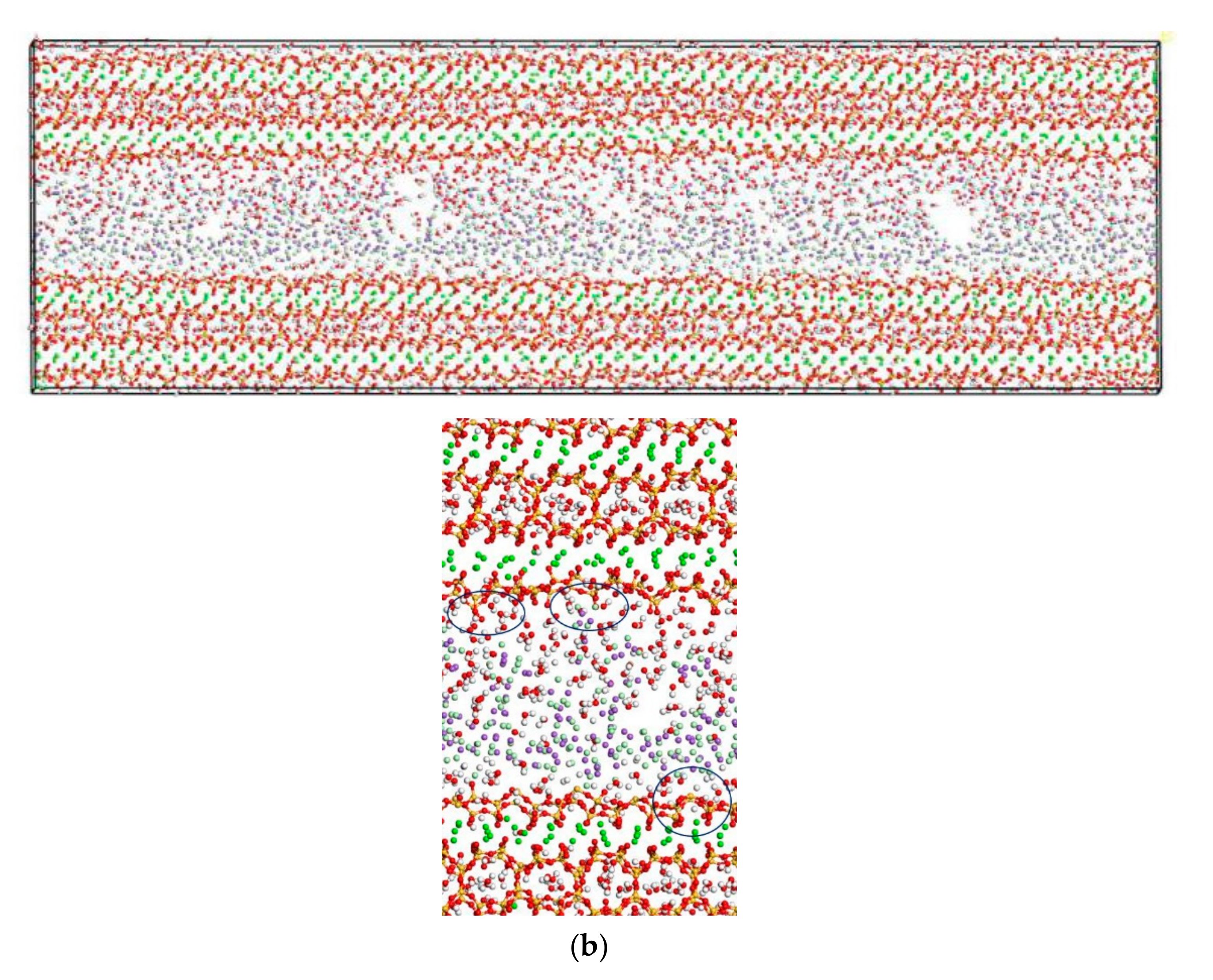

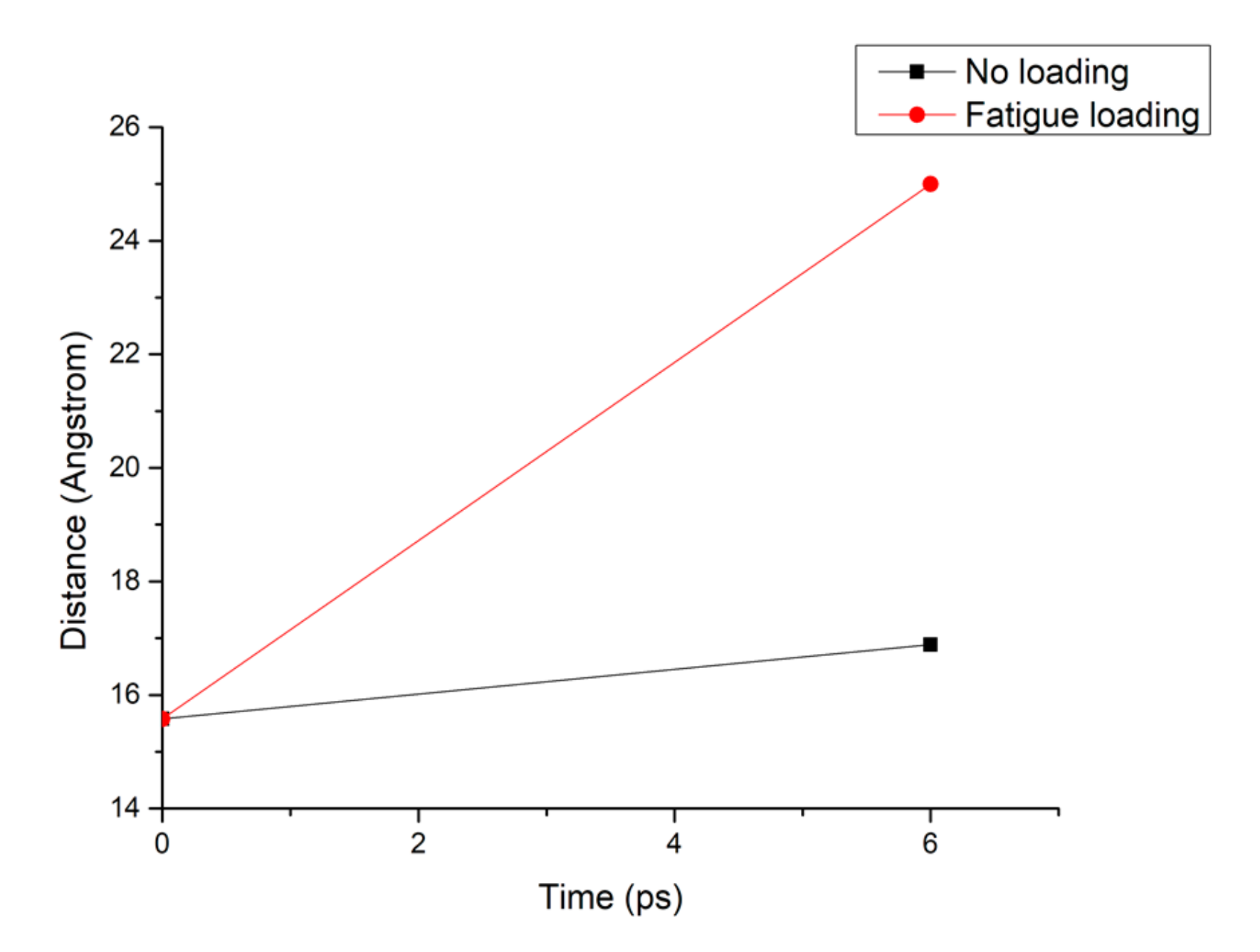

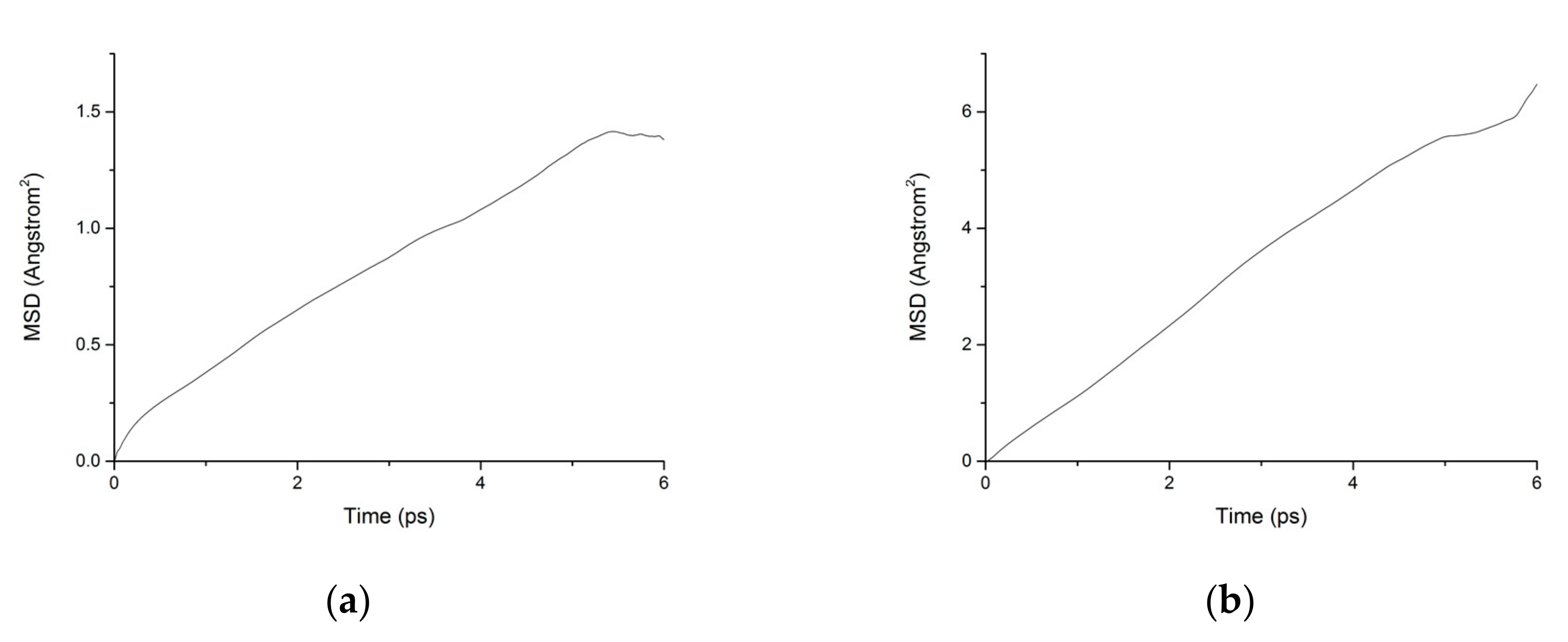
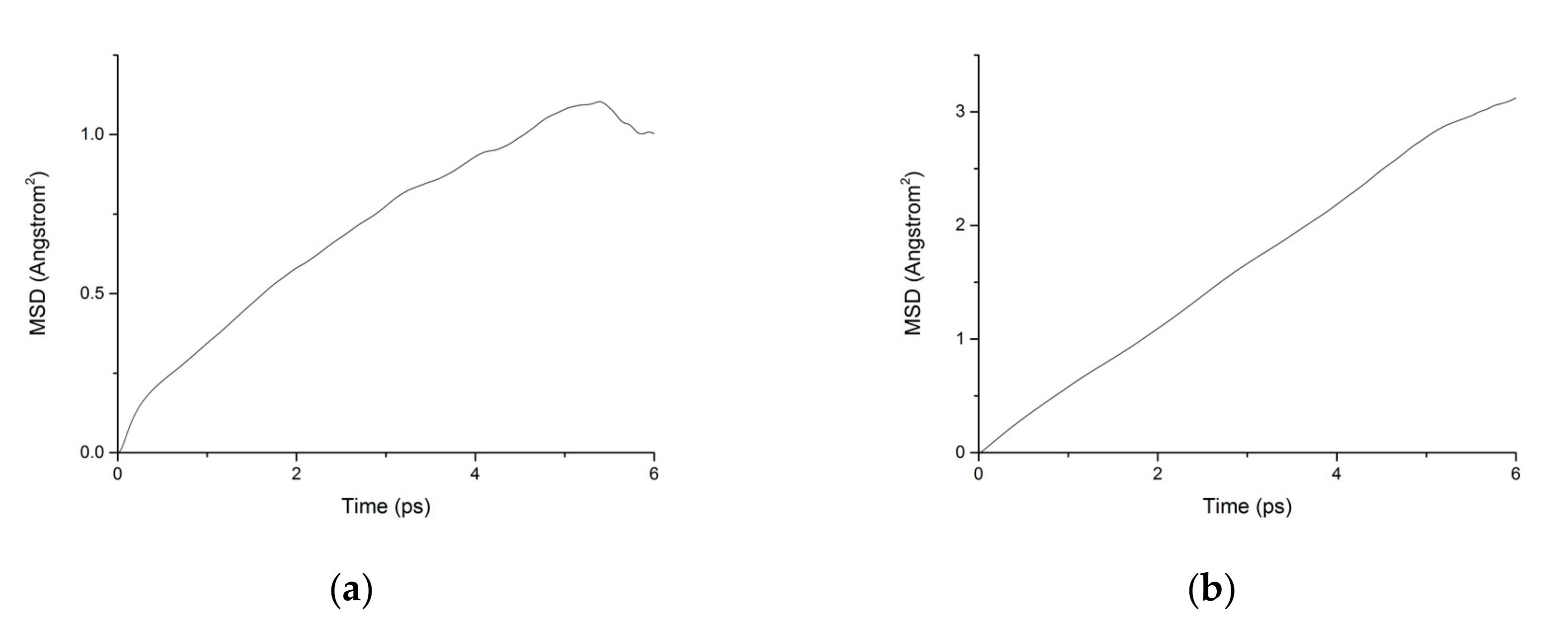
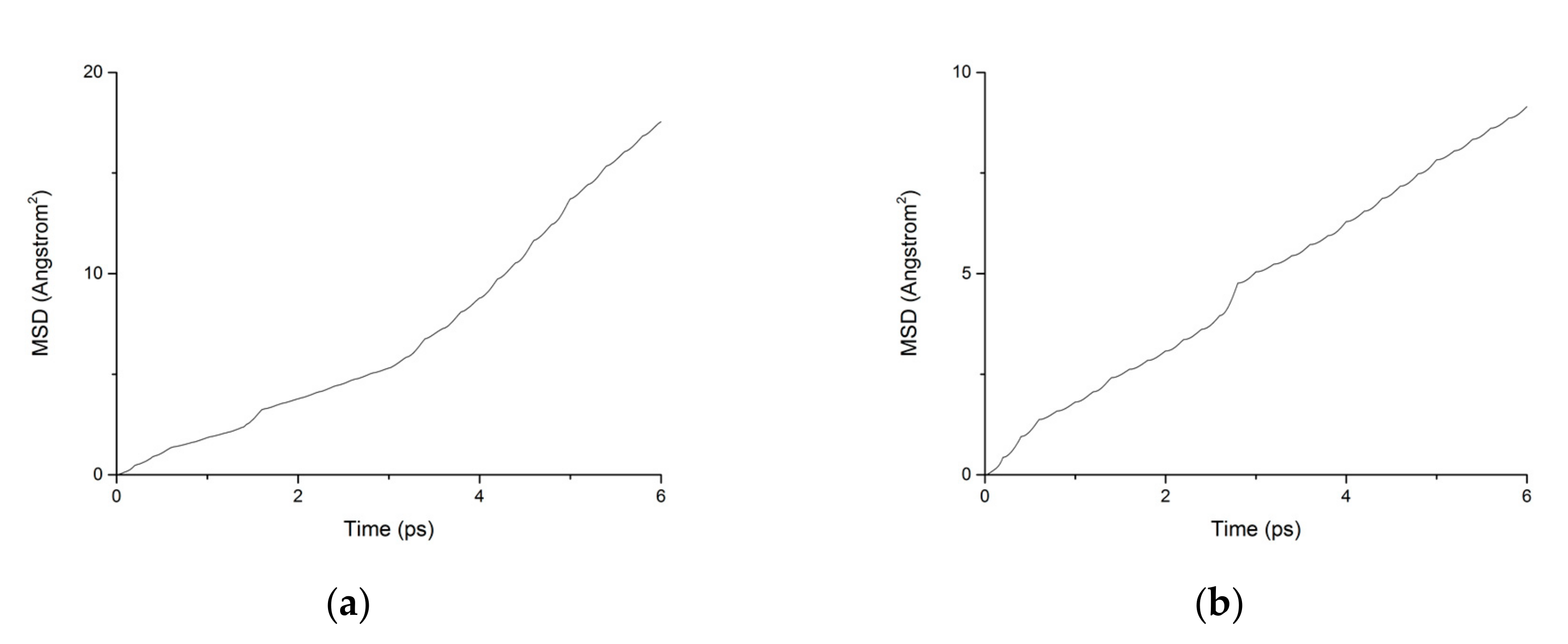
| Category | Tobermorite 11 Å |
|---|---|
| Space group | Bm |
| Crystal system | Monoclinic |
| a/Å | 6.732 |
| b/Å | 7.369 |
| c/Å | 22.68 |
| α/° | 90 |
| β/° | 90 |
| γ/° | 123.18 |
| Diffusion Coefficient (×10−9 m2/s) | Without Fatigue Loading | Under Fatigue Loading | |
|---|---|---|---|
| Pore Diameter: 1.5 nm | Pore Diameter: 3.0 nm | ||
| Chloride ion | 0.287 | 0.896 | 2.502 |
| Water molecule | 0.383 | 1.794 | 4.779 |
© 2020 by the authors. Licensee MDPI, Basel, Switzerland. This article is an open access article distributed under the terms and conditions of the Creative Commons Attribution (CC BY) license (http://creativecommons.org/licenses/by/4.0/).
Share and Cite
Cao, Q.; Xu, Y.; Fang, J.; Song, Y.; Wang, Y.; You, W. Influence of Pore Size and Fatigue Loading on NaCl Transport Properties in C-S-H Nanopores: A Molecular Dynamics Simulation. Materials 2020, 13, 700. https://doi.org/10.3390/ma13030700
Cao Q, Xu Y, Fang J, Song Y, Wang Y, You W. Influence of Pore Size and Fatigue Loading on NaCl Transport Properties in C-S-H Nanopores: A Molecular Dynamics Simulation. Materials. 2020; 13(3):700. https://doi.org/10.3390/ma13030700
Chicago/Turabian StyleCao, Qingyu, Yidong Xu, Jianke Fang, Yufeng Song, Yao Wang, and Weiguo You. 2020. "Influence of Pore Size and Fatigue Loading on NaCl Transport Properties in C-S-H Nanopores: A Molecular Dynamics Simulation" Materials 13, no. 3: 700. https://doi.org/10.3390/ma13030700
APA StyleCao, Q., Xu, Y., Fang, J., Song, Y., Wang, Y., & You, W. (2020). Influence of Pore Size and Fatigue Loading on NaCl Transport Properties in C-S-H Nanopores: A Molecular Dynamics Simulation. Materials, 13(3), 700. https://doi.org/10.3390/ma13030700






